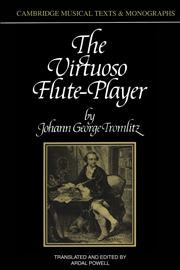Book contents
- Frontmatter
- Contents
- Translator's note
- Introduction by Eileen Hadidian
- Title in the series
- DETAILED AND THOROUGH TUTOR FOR PLAYING THE FLUTE
- Foreword
- Introduction
- 1 The flute and its character
- 2 Holding the flute, and the embouchure
- 3 Fingering
- 4 The notes and rests, their values and denominations, and the other musical signs
- 5 Time-signatures, and how the notes are divided and counted in them; the beat itself, or counting time according to an appointed tempo
- 6 Tone and pure intonation
- 7 Modern key-signatures
- 8 The articulation proper to this instrument, or the means of governing the wind suitably, as well in slow as in moderately quick movements; also called the single tongue
- 9 The technique for executing fast and very fast passages clearly and roundly; also, though improperly, called the ‘double tongue’
- 10 The ornaments
- 11 The trill
- 12 Fermatas and cadenzas
- 13 The taking of breath in flute-playing
- 14 The discretionary ornaments; or how to vary a simple melody according to the rules of harmony, and to use these variations in a good and suitable way appropriate to the material
- 15 Summary of the whole, together with a few remarks for pupils and masters
- Fingering-chart
- Select bibliography
- Index
1 - The flute and its character
Published online by Cambridge University Press: 01 June 2011
- Frontmatter
- Contents
- Translator's note
- Introduction by Eileen Hadidian
- Title in the series
- DETAILED AND THOROUGH TUTOR FOR PLAYING THE FLUTE
- Foreword
- Introduction
- 1 The flute and its character
- 2 Holding the flute, and the embouchure
- 3 Fingering
- 4 The notes and rests, their values and denominations, and the other musical signs
- 5 Time-signatures, and how the notes are divided and counted in them; the beat itself, or counting time according to an appointed tempo
- 6 Tone and pure intonation
- 7 Modern key-signatures
- 8 The articulation proper to this instrument, or the means of governing the wind suitably, as well in slow as in moderately quick movements; also called the single tongue
- 9 The technique for executing fast and very fast passages clearly and roundly; also, though improperly, called the ‘double tongue’
- 10 The ornaments
- 11 The trill
- 12 Fermatas and cadenzas
- 13 The taking of breath in flute-playing
- 14 The discretionary ornaments; or how to vary a simple melody according to the rules of harmony, and to use these variations in a good and suitable way appropriate to the material
- 15 Summary of the whole, together with a few remarks for pupils and masters
- Fingering-chart
- Select bibliography
- Index
Summary
How the flute came by its external structure in former times, and how it is constructed now, will no doubt already be known to most people. Formerly it was in one piece: but since this type was not only inconvenient, but also useless as regards raising or lowering the pitch, it was divided into three parts: a head-joint, a middle joint in which were six holes, and the foot. This was a step in the right direction: it was easier to carry it around, and to tune it by making several longer or shorter six-holed middle joints. But in respect of building technique, it was still very inferior, and it would not have been possible to develop it further if the six-holed middle piece had been left intact. So it was necessary to divide the middle piece once more, and that is how the present kind of flute originated. The reasons why it was thus divided will be found below.
Now the actual reasons why it was divided are not just to do with tuning, or still less convenience of transportation, for the latter is the least significant. Although perhaps this may have been the only intention at the time, a far more important reason for it can be given. In any case, whether the flute was divided by accident or design, such is its nature that the way it is divided nowadays cannot be changed without disadvantage, unless one is to have to throw away the instrument after a short period of use.
- Type
- Chapter
- Information
- The Virtuoso Flute-Player , pp. 25 - 42Publisher: Cambridge University PressPrint publication year: 1991

